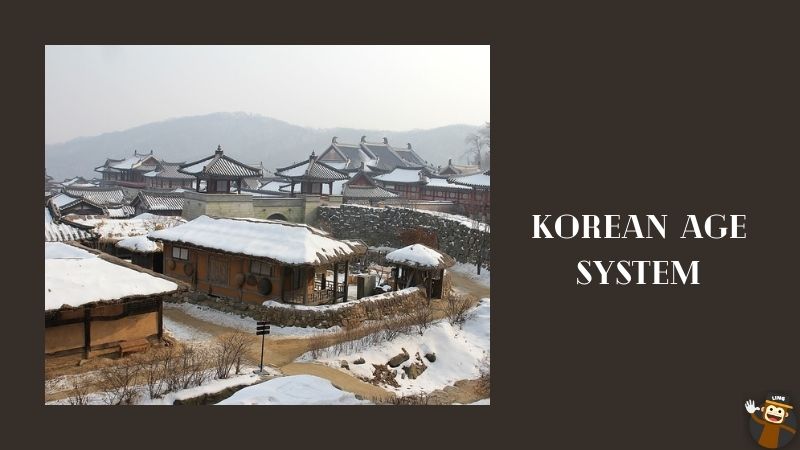Did you know that the Korean age is not the same as the age you might be aware of? Your age might be different once you go to South Korea. To save you from such a cultural shock, we will give you all the significant details that you need about the Korean age in this blog post. If you are ready for that, then let’s dive right into it!
Korean Age System

The Korean age system is technically very unique and different. It does not follow the Gregorian calendar. The Korean age, 한국 나이 (Hanguk nai), needs to be calculated according to the Lunar calendar. The age in other areas like Eastern Mongolia had comparatively different systems for calculations as compared to the Korean system.
The traditional Korean age is used by adding the unit sal (살) at the end. Sal (살) means a year in the Korean language. This can be added with both one and more than one number since the rules of plurality are not especially important in Korean culture.
Brief History
The Chinese people tend to say that their children are born with sui 嵗/岁, which technically means that they are born with one year of life. They then have to follow the Lunar calendar to change their age and become one year older. It is 두 살 (du sal) in Korean that means two years old.
If we look at history, we would realize that this system was prevalent among all the Chinese-influenced East Asian cultural spheres: China, Japan, Korea, Viet Nam, and some other regions.
Difference Between Korean And International Age
Korean people use two age systems, and therefore they must have a way to distinguish between both ages. As you may know that there are two types of number systems used in the Korean language: Sino Korean numbers and native Korean numbers.
While using the Sino Korean numbers to tell the age, you should use the age units 세 (se) and 살 (sal) while using the native Korean numbers. For example, 칠세 (chilse) would be seven years old in the Sino Korean numbers and 두살 (dusal) would be two years in native Korean numbers.
Now to differentiate the traditional Korean age from the international age system, i.e., 만나이 (man-nai), the Korean people will add the word 만 (man) before the age/number. For instance, 두살 (dusal) using the international system will be 만두살 (man dusal).
You should also know that if the Korean people are casually talking to each other without any professional/formal connotation to their conversation then they would be using the traditional Korean system 한국 나이 (Hanguk nai) instead of 만나이 (man-nai).
Year Age
While learning about the Korean age system, it is important to know about the concept of year age in South Korea. Year age is adding one to the actual age. If you measure your age according to the western system, you need to add one in it to have your year age.
January 1st
Each Korean person gets one year older on January 1st. This is not a hard and fast rule. It is just a way of Korean culture to increase the age of people and make them get older. If your baby is born on New year’s day, it is not one year old after a day but two years old, which might fascinate you.
At the start of the Lunar year, the age changes all of a sudden, so even a day can make you get one year older than you were the day before that.
The Legal Drinking Age In Korea
The legal drinking age in Korea is international 19 years which could be Korean 20 or even 21 years if the person was not born on the same day a year ago. At this age, it is legally permitted to drink in Korea. Other things are told using the international age system, such as the legal age to watch movies that are supposed to be watched at a specific age, etc.
Celebrating 백일 (baegil)

If you are a non-Korean person, you might not know about 백일 (baegil), which is celebrated on the 100th of birth in Korea. You can think of it as a milestone that a child has achieved, and the parents and relatives are eager to celebrate. If this does not make much sense to you, then allow us to give you a glimpse of its context.
Context Of 백일 (baegil)
In ancient times, children used to die because of countless reasons. The seasons used to be extreme for the babies to survive, and thus the babies used to suffer a lot. The medical conditions were also not advanced like they are these days. Many children used to either die because of famine or harsh weather conditions.
To prevent the babies from dying at that time, the parents used to keep their children hidden from all such hazards for the first 100 days. It was believed that an infant who easily passes the first 100 days of their birth tends to be healthy and can live a long life.
The parents spent their time praying to god for their child’s health and consulting shamans to ask about how to proceed. Once their child passes that crucial time, the entire family celebrates that event zealously.
The family used to gather together and have a feast. They showed their gratitude to the gods and gave shamans and the people food. In those times, 백일 (baegil) was extremely important for every Korean person. Nowadays, people do not celebrate 백일 (baegil) as much as they used to. These days, more importance is given to dol (돌), which is the first anniversary of a child’s birthday.
Calculating The Korean Age

Here we bring you an easy formula to learn and use to calculate your Korean age. Korean Age = (Current Year − Birth Year) + 1. If you ever find yourself confused about the Korean age, this should be your go-to formula.
Let’s look at all the Korean ages
| International Age- 만 나이 (man nai) | Korean Age- 한국 나이 (Hanguk nai) | English Translation |
| 만 한 살 – man han sal | 한 살 – han sal | 1 year old |
| 만 두 살 – man du sal | 두 살 – du sal | 2 years old |
| 만 세 살 – man se sal | 세 살 – se sal | 3 years old |
| 만 네 살 – man ne sal | 네 살 – ne sal | 4 years old |
| 만 다섯 살 – man daseot sal | 다섯 살 – daseot sal | 5 years old |
| 만 여섯 살 – man yeoseot sal | 여섯 살 – yeoseot sal | 6 years old |
| 만 일곱 살 – man ilgop sal | 일곱 살 – ilgop sal | 7 years old |
| 만 여덟 살 – man yeodeol sal | 여덟 살 – yeodeol sal | 8 years old |
| 만 아홉 살 – man ahop sal | 아홉 살 – ahop sal | 9 years old |
| 만 열 살 – man yeol sal | 열 살 – yeol sal | 10 years old |
| 만 열한 살 – man yeolhan sal | 열한 살 – yeolhan sal | 11 years old |
| 만 열두 살 – man yeoldu sal | 열두 살 – yeoldu sal | 12 years old |
| 만 열세 살 – man yeolse sal | 열세 살 – yeolse sal | 13 years old |
| 만 열네 살 – man yeolle sal | 열네 살 – yeolle sal | 14 years old |
| 만 열다섯 살 – man yeoldaseot sal | 열다섯 살 – yeoldaseot sal | 15 years old |
| 만 열여섯 살 – man yeollyeoseot sal | 열여섯 살 – yeollyeoseot sal | 16 years old |
| 만 열일곱 살 – man yeorilgop sal | 열일곱 살 – yeorilgop sal | 17 years old |
| 만 열여덟 살 – man yeollyeodeol sal | 열여덟 살 – yeollyeodeol sal | 18 years old |
| 만 열아홉 살 – man yeorahop sal | 열아홉 살 – yeorahop sal | 19 years old |
| 만 스무 살 – man seumu sal | 스무 살 – seumu sal | 20 years old |
| 만 스물한 살 – man seumulhan sal | 스물한 살 – seumulhan sal | 21 years old |
| 만 스물두 살 – man seumuldu sal | 스물두 살 – seumuldu sal | 22 years old |
| 만 스물세 살 – man seumulse sal | 스물세 살 – seumulse sal | 23 years old |
| 만 스물네 살 – man seumulle sal | 스물네 살 – seumulle sal | 24 years old |
| 만 스물다섯 살 – man seumuldaseot sal | 스물다섯 살 – seumuldaseot sal | 25 years old |
| 만 스물여섯 살 – man seumullyeoseot sal | 스물여섯 살 – seumullyeoseot sal | 26 years old |
| 만 스물일곱 살 – man seumurilgop sal | 스물일곱 살 – seumurilgop sal | 27 years old |
| 만 스물여덟 살 – man seumullyeodeol sal | 스물여덟 살 – seumullyeodeol sal | 28 years old |
| 만 스물아홉 살 – man seumurahop sal | 스물아홉 살 – seumurahop sal | 29 years old |
| 만 서른 살 – man seoreun sal | 서른 살 – seoreun sal | 30 years old |
| 만 서른한 살 – man seoreunhan sal | 서른한 살 – seoreunhan sal | 31 years old |
| 만 서른두 살 – man seoreundu sal | 서른두 살 – seoreundu sal | 32 years old |
| 만 서른세 살 – man seoreunse sal | 서른세 살 – seoreunse sal | 33 years old |
| 만 서른네 살 – man seoreunne sal | 서른네 살 – seoreunne sal | 34 years old |
| 만 서른다섯 살 – man seoreundaseot sal | 서른다섯 살 – seoreundaseot sal | 35 years old |
| 만 서른여섯 살 – man seoreunyeoseot sal | 서른여섯 살 – seoreunyeoseot sal | 36 years old |
| 만 서른일곱 살 – man seoreunilgop sal | 서른일곱 살 – seoreunilgop sal | 37 years old |
| 만 서른여덟 살 – man seoreunyeodeol sal | 서른여덟 살 – seoreunyeodeol sal | 38 years old |
| 만 서른아홉 살 – man seoreunahop sal | 서른아홉 살 – seoreunahop sal | 39 years old |
| 만 마흔 살 – man maheun sal | 마흔 살 – maheun sal | 40 years old |
| 만 마흔한 살 – man maheunhan sal | 마흔한 살 – maheunhan sal | 41 years old |
| 만 마흔두 살 – man maheundu sal | 마흔두 살 – maheundu sal | 42 years old |
| 만 마흔세 살 – man maheunse sal | 마흔세 살 – maheunse sal | 43 years old |
| 만 마흔네 살 – man maheunne sal | 마흔네 살 – maheunne sal | 44 years old |
| 만 마흔다섯 살 – man maheundaseot sal | 마흔다섯 살 – maheundaseot sal | 45 years old |
| 만 마흔여섯 살 – man maheunyeoseot sal | 마흔여섯 살 – maheunyeoseot sal | 46 years old |
| 만 마흔일곱 살 – man maheunilgop sal | 마흔일곱 살 – maheunilgop sal | 47 years old |
| 만 마흔여덟 살 – man maheunyeodeol sal | 마흔여덟 살 – maheunyeodeol sal | 48 years old |
| 만 마흔아홉 살 – man maheunahop sal | 마흔아홉 살 – maheunahop sal | 49 years old |
| 만 쉰 살 – man swin sal | 쉰 살 – swin sal | 50 years old |
| 만 쉰한 살 – man swinhan sal | 쉰한 살 – swinhan sal | 51 years old |
| 만 쉰두 살 – man swindu sal | 쉰두 살 – swindu sal | 52 years old |
| 만 쉰세 살 – man swinse sal | 쉰세 살 – swinse sal | 53 years old |
| 만 쉰네 살 – man swinne sal | 쉰네 살 – swinne sal | 54 years old |
| 만 쉰다섯 살 – man swindaseot sal | 쉰다섯 살 – swindaseot sal | 55 years old |
| 만 쉰여섯 살 – man swinyeoseot sal | 쉰여섯 살 – swinyeoseot sal | 56 years old |
| 만 쉰일곱 살 – man swinilgop sal | 쉰일곱 살 – swinilgop sal | 57 years old |
| 만 쉰여덟 살 – man swinyeodeol sal | 쉰여덟 살 – swinyeodeol sal | 58 years old |
| 만 쉰아홉 살 – man swinahop sal | 쉰아홉 살 – swinahop sal | 59 years old |
| 만 예순 살 – man yesun sal | 예순 살 – yesun sal | 60 years old |
| 만 예순한 살 – man yesunhan sal | 예순한 살 – yesunhan sal | 61 years old |
| 만 예순두 살 – man yesundu sal | 예순두 살 – yesundu sal | 62 years old |
| 만 예순세 살 – man yesunse sal | 예순세 살 – yesunse sal | 63 years old |
| 만 예순네 살 – man yesunne sal | 예순네 살 – yesunne sal | 64 years old |
| 만 예순다섯 살 – man yesundaseot sal | 예순다섯 살 – yesundaseot sal | 65 years old |
| 만 예순여섯 살 – man yesunyeoseot sal | 예순여섯 살 – yesunyeoseot sal | 66 years old |
| 만 예순일곱 살 – man yesunilgop sal | 예순일곱 살 – yesunilgop sal | 67 years old |
| 만 예순여덟 살 – man yesunyeodeol sal | 예순여덟 살 – yesunyeodeol sal | 68 years old |
| 만 예순아홉 살 – man yesunahop sal | 예순아홉 살 – yesunahop sal | 69 years old |
| 만 일흔 살 – man ilheun sal | 일흔 살 – ilheun sal | 70 years old |
| 만 일흔한 살 – man ilheunhan sal | 일흔한 살 – ilheunhan sal | 71 years old |
| 만 일흔두 살 – man ilheundu sal | 일흔두 살 – ilheundu sal | 72 years old |
| 만 일흔세 살 – man ilheunse sal | 일흔세 살 – ilheunse sal | 73 years old |
| 만 일흔네 살 – man ilheunne sal | 일흔네 살 – ilheunne sal | 74 years old |
| 만 일흔다섯 살 – man ilheundaseot sal | 일흔다섯 살 – ilheundaseot sal | 75 years old |
| 만 일흔여섯 살 – man ilheunyeoseot sal | 일흔여섯 살 – ilheunyeoseot sal | 76 years old |
| 만 일흔일곱 살 – man ilheunilgop sal | 일흔일곱 살 – ilheunilgop sal | 77 years old |
| 만 일흔여덟 살 – man ilheunyeodeol sal | 일흔여덟 살 – ilheunyeodeol sal | 78 years old |
| 만 일흔아홉 살 – man ilheunahop sal | 일흔아홉 살 – ilheunahop sal | 79 years old |
| 만 여든 살 – man yeodeun sal | 여든 살 – yeodeun sal | 80 years old |
| 만 여든한 살 – man yeodeunhan sal | 여든한 살 – yeodeunhan sal | 81 years old |
| 만 여든두 살 – man yeodeundu sal | 여든두 살 – yeodeundu sal | 82 years old |
| 만 여든세 살 – man yeodeunse sal | 여든세 살 – yeodeunse sal | 83 years old |
| 만 여든네 살 – man yeodeunne sal | 여든네 살 – yeodeunne sal | 84 years old |
| 만 여든다섯 살 – man yeodeundaseot sal | 여든다섯 살 – yeodeundaseot sal | 85 years old |
| 만 여든여섯 살 – man yeodeunyeoseot sal | 여든여섯 살 – yeodeunyeoseot sal | 86 years old |
| 만 여든일곱 살 – man yeodeunilgop sal | 여든일곱 살 – yeodeunilgop sal | 87 years old |
| 만 여든여덟 살 – man yeodeunyeodeol sal | 여든여덟 살 – yeodeunyeodeol sal | 88 years old |
| 만 여든아홉 살 – man yeodeunahop sal | 여든아홉 살 – yeodeunahop sal | 89 years old |
| 만 아흔 살 – man aheun sal | 아흔 살 – aheun sal | 90 years old |
| 만 아흔한 살 – man aheunhan sal | 아흔한 살 – aheunhan sal | 91 years old |
| 만 아흔두 살 – man aheundu sal | 아흔두 살 – aheundu sal | 92 years old |
| 만 아흔세 살 – man aheunse sal | 아흔세 살 – aheunse sal | 93 years old |
| 만 아흔네 살 – man aheunne sal | 아흔네 살 – aheunne sal | 94 years old |
| 만 아흔다섯 살 – man aheundaseot sal | 아흔다섯 살 – aheundaseot sal | 95 years old |
| 만 아흔여섯 살 – man aheunyeoseot sal | 아흔여섯 살 – aheunyeoseot sal | 96 years old |
| 만 아흔일곱 살 – man aheunilgop sal | 아흔일곱 살 – aheunilgop sal | 97 years old |
| 만 아흔여덟 살 – man aheunyeodeol sal | 아흔여덟 살 – aheunyeodeol sal | 98 years old |
| 만 아흔아홉 살 – man aheunahop sal | 아흔아홉 살 – aheunahop sal | 99 years old |
| 만 백 살 – man baek sal | 백 살 – baek sal | 100 years old |
| 만 백한 살 – man baekan sal | 백한 살 – baekan sal | 101 years old |
| 만 백두 살 – man baekdu sal | 백두 살 – baekdu sal | 102 years old |
| 만 백세 살 – man baekse sal | 백세 살 – baekse sal | 103 years old |
| 만 백네 살 – man baengne sal | 백네 살 – baengne sal | 104 years old |
| 만 백다섯 살 – man baekdaseot sal | 백다섯 살 – baekdaseot sal | 105 years old |
| 만 백여섯 살 – man baengnyeoseot sal | 백여섯 살 – baengnyeoseot sal | 106 years old |
| 만 백일곱 살 – man baegilgop sal | 백일곱 살 – baegilgop sal | 107 years old |
| 만 백여덟 살 -man baengnyeodeol sal | 백여덟 살 – baengnyeodeol sal | 108 years old |
| 만 백아홉 살 – man baegahop sal | 백아홉 살 – baegahop sal | 109 years old |
| 만 백열 살 – man baengnyeol sal | 백열 살 – baengnyeol sal | 110 years old |
| 만 백열한 살 – man baengnyeolhan sal | 백열한 살 – baengnyeolhan sal | 111 years old |
How To Ask Someone’s Age
There are several ways to ask about someone’s age. All of those ways depend upon the level of formality and speech in the Korean language. Let’s learn some of the most common ways.
몇 살이야? (myeot sa-ri-ya?)
The most informal way of asking someone’s age in Korean is 몇 살이야? (myeot sa-ri-ya?). Western countries don’t have such specific expressions. Most of the Korean people talking to younger people ask 몇 살이야? (myeot sa-ri-ya?).
나이가 어떻게 되십니까? (na-i-ga eo-tteo-kke doe-sim-ni-kka?)
This is yet another phrase. It is a good way to ask how old someone is. However, this is a very formal way of asking and is usually asked from an individual with a very higher authority like the president, etc.
몇 살이에요? (myeot sa-ri-e-yo?)
While talking to the strangers, Korean people tend to ask 몇 살이에요? (myeot sa-ri-e-yo?). Strangers are not the people that you can easily be casual or informal with. Some might feel okay but mostly could feel offended and awkward.
Like they say “better safe than sorry”, ask 몇 살이에요? (myeot sa-ri-e-yo?) from everyone around you.
나이가 어떻게 되세요? (na-i-ga eo-tteo-kke doe-se-yo?)
Let’s take the respect up a notch and learn how to ask age in an even more informal way. 나이가 어떻게 되세요? (na-i-ga eo-tteo-kke doe-se-yo?) is a nice and respectful way of asking someone’s age. While talking to your senior or boss, you could ask 나이가 어떻게 되세요? (na-i-ga eo-tteo-kke doe-se-yo?) if you are curious.
연세가 어떻게 되십니까? (yeon-se-ga eo-tteo-kke doe-sim-ni-kka?)
Talking to a really old person like older 60 years or older? This phrase has the word 연세 (yeonse), which is a formal way of saying age.
몇 년생이에요? (myeot nyeon-saeng-i-e-yo?)
Another respectful way to ask someone their age is 몇 년생이에요? (myeot nyeon-saeng-i-e-yo?). The person might tell you their year of birth. If someone asks this, you can tell the year you were born.
How To Respond
To respond to such questions, you could use the following phrases:
| Korean Sentences | Romanized Korean | English Translation |
| 제 나이는 20살입니다. | je naineun 20sal-ibnida. | My age is 20 years. |
| 저는 20세(한국 나이)입니다. | jeoneun 20se(hangug nai)ibnida. | I am 20 years old (Korean age) |
| 저는 20세입니다(국제 연령) | jeoneun 20seibnida(gugje yeonlyeong) | I am 20 years old (International age) |
| 20 살. | 20 sal. | 20 years old. |
Same Age Response
If you realize that you are the same age as someone else, then feel free to say 우리는 동갑이다 (urineun donggapida). This means that “we both are of the same age.” You don’t need to follow the formal rules anymore, and feel free to try being casual with a person who says this.
Wrapping Up

Hopefully, you had a lot to learn in this blog post. Besides learning how to ask and tell age, you also learned about the Korean age system. If you liked this blog, you must also be interested in checking out the best words for describing body parts and ways to say sorry in Korean.
Also, be sure to download the Ling App. The Ling App by Simya Solutions is a great platform to start learning any language. With different options to learn, your language learning can go perfectly. Learn more about its unique features here.
Happy Learning!































































